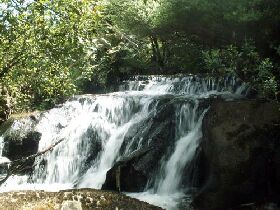Backyard HydropowerTasmanaian Village becomes energy self-sufficient
Across Australia, the cost of electricity is a big issue. Tasmania is no different with anger over soaring power costs and conflict between the state’s energy companies. More and more people are searching for alternatives and an ex-engineer has come up with a bright idea that’s now powering his entire town.
Hugging the foothills of Mt Field, the tiny hamlet of Ellendale epitomises the bewitching peace of Tasmanian farming towns. Life centres around a main road, the church, the shop and the Town Hall. It’s hard to believe on one of Ellendale’s story book farms a quiet revolution is taking place.
Nigel Tomlin has a cottage and now a power station. He retired to this farm near the Jones River hoping for the quiet life, after a 17 year career working as an engineer with energy companies around the world.
With his property ideally placed at the base of a stream, he couldn’t resist the urge to tap in. “I’ve had a passion for the power of water; the potential in hydro power generation, the property here is on the stream, ” he said.
Nigel was not only inspired to design the clean green energy efficient hydro generator he’d been dreaming about for 22 years, he built it at the bottom of his garden. The call went out to his old network and together Mr Tomlin and five ex-hydro engineers spent five months welding and connecting their mini hydro generator from scratch. It’s now pumping out 80 megawatt hours a year, that’s enough energy to power the entire town.
Housed in the tiny stone cottage, water is piped 500 metres from the top of the river until it reaches the base of the cottage. By the time it reaches the valve, the water has dropped 30 metres. It’s the momentum from this drop that drives the turbines.
At a cost of $35,000, Tomlin says his generator is about 30 per cent more efficient than most Aurora power stations currently operating in Tasmania.
“It’s generated nine megawatt hours. It has an average output throughout the year of 7.5 kilowatts and it will deliver between 60 and 80 megawatt hours annually,” said Tomnlin. That’s because of a direct cottage to grid system which saves energy loss during generation. And also there’s no transformers on site which often give trouble near waterways.
The system has the attention of engineers at energy company Aurora, who have asked him to share his design secrets. The inventor says there’s no secret, just a new way of combining two old engineering ideas. He says building the mini hydro at the head of a stream cuts the need for a dam and large scale equipment.
“You don’t have to have a lot of equipment such as speed control governing, voltage control and, so the system can being installed quite cheaply. A simple induction generator channels the water’s momentum — similar to the motor on a cement mixer or a washing machine.
Piping is made from new materials that don’t need lubrication, cutting out water contamination.
“The dams are always the environmental issue and not only environmental issue, but the cost issue. Usually the dam in a hydro project costs probably 80 to 90 per cent of the project,” says Tomlin. He says the simple idea of placing more generators at the head of Tasmania’s many streams and rivers can save money and the environment.
“With the national grid, with everything hooked up together, there’s no need for the storage, as there was years ago.”

4 Responses
we have large river running through are area
that could power may places and town near us
love to build one in cleveland river it tilited
waters which i think make good site for this
cane you suggest anything to help me
also want to build private home with good size river on it that could provide use good power too will give me idea on how to build my own please thank you troy
Is the tasmanian victorian pipeline a real plausible solution? https://www.youtube.com/watch?v=ADVB3DqEYK0&feature=youtube_gdata
If so, how much power can be delivered from such a system?
Would love feedback from you,
kind regards, Udi Tal.
I saw your property on the TV and was intrigued with how the buildings were constructed of stone and cement and was hopeful you could tell me how this was done.Cheers Kathy
Hi all.
We have a much smaller system at our retreat in cape Breton, generates 1.1kwhr 24×7. and have the ability to increase output threefold if required.
If you have running water this is a excellent way to produce power, our blog is on Live Journal at
https://willowretreat.livejournal.com/2521.html
Paul and Anne